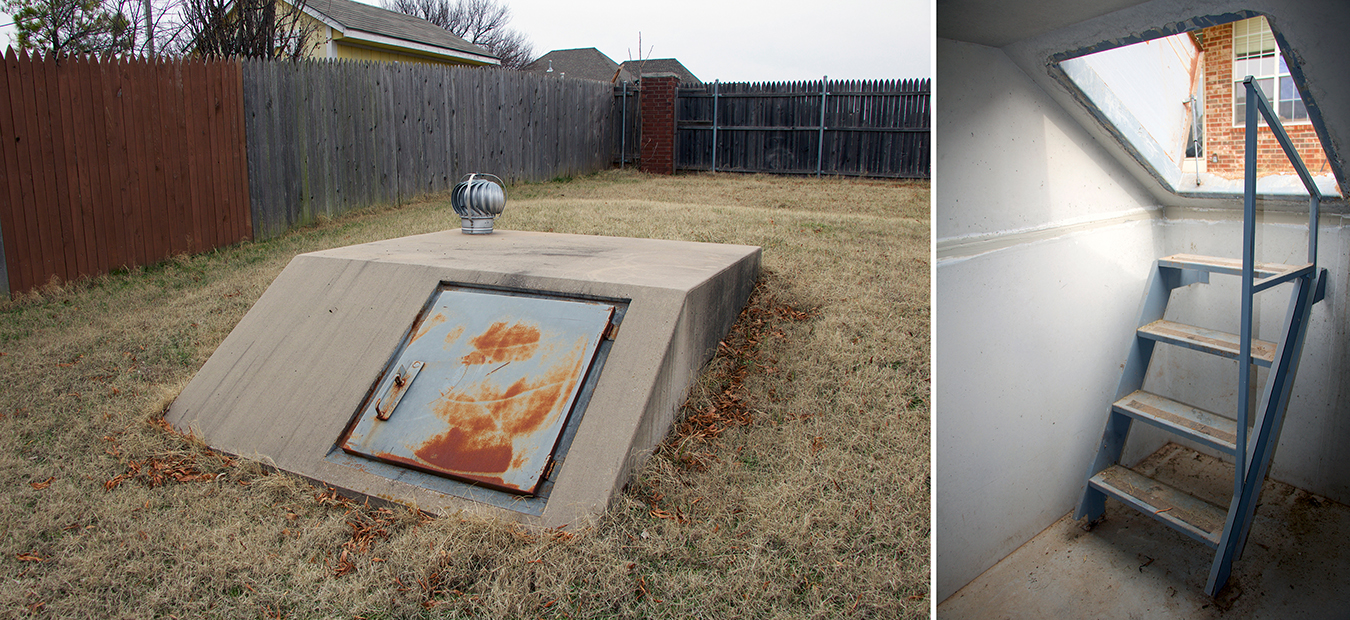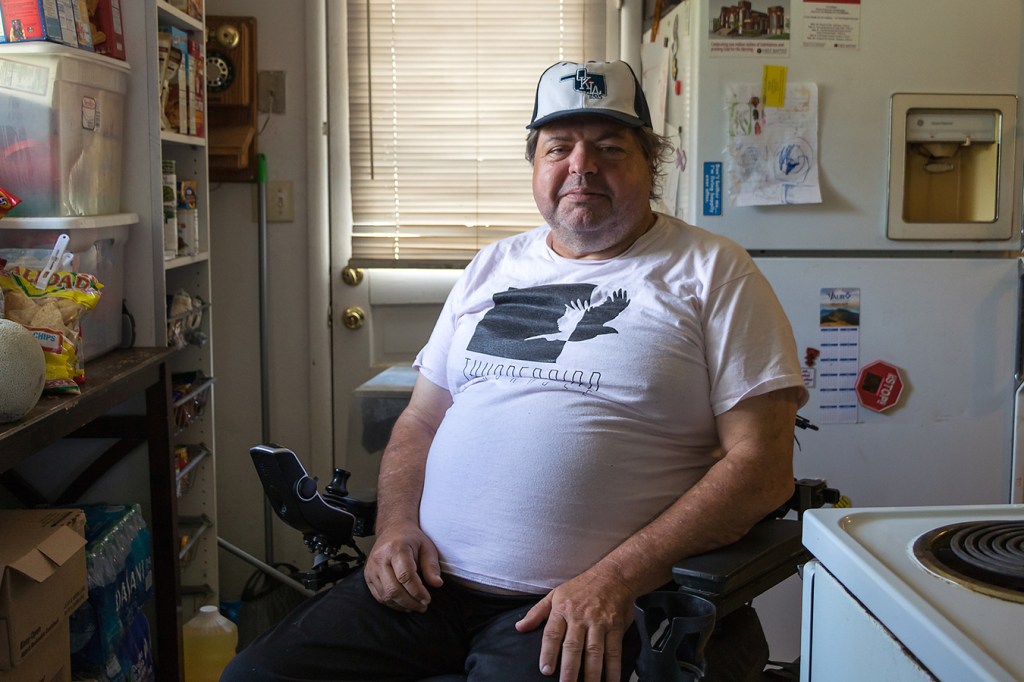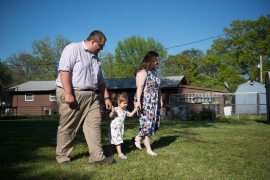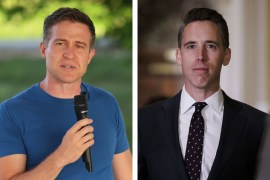John High has diabetes, which led to his leg being amputated below the knee two years ago. He has been using a wheelchair since then and hasn’t gotten used to having to work out solutions to everyday problems — such as getting into and out of the shower in the small rental house he shares with his son in Norman, Oklahoma. And when he hears a tornado siren blaring out its high-pitched warning, he feels a spasm of fear and dread. He knows he’s on his own.
“I just pray. That’s all I can do,” High said. “They expect people to ‘shelter in place,’ but I don’t have anywhere safe to go.”
Other Oklahomans have had to adapt, too. Few homes have basements, so residents who can afford to do so build or purchase their own shelters. But High can’t afford the kind he would need — one that would allow him to quickly roll his motorized chair inside. And few others see this as a problem.
“One person told me, ‘Put on a football helmet and go into your kitchen,'” High recalled with a bitter smile. “I’ve got a window in every room of this house, so there’s really no place for me to go.”
He wasn’t always in this situation. High chose this rental house in 2008 because of its proximity to a public elementary school that was officially designated as a public shelter. From his driveway, High can see the school down the street. It would take four minutes for him to roll down a ramp, travel along the sidewalk and enter the school gym.
But access to most places that have served as public shelters in the past, including that gym, ended a few years ago after fire officials and others argued that the public shelters weren’t up to federal standards. Effectively, that change in policy left Oklahomans like High to fend for themselves.
The protective gold standard for people who live in tornado-prone regions is a storm shelter, also known as a safe room. They can be purchased at big-box hardware stores, or specialty companies can build concrete shelters. The structures range in price from a few thousand to tens of thousands of dollars, depending on the size and materials. The base model is a concrete room set into the ground, usually in a backyard. To get inside, people must climb down a ladder or steep set of stairs. Above-ground models that are wheelchair-accessible cost more.
High relies on federal disability payments for his income and said he simply can’t afford to pay for his own shelter.
“What bill am I going to not pay, to try to save up $3,800? I live day to day. Every month is really rough,” he said.
Towns started closing public shelters in Oklahoma a few years ago, to avoid the costs of making them tornado-safe. There was no mandate that municipalities keep them open. High said he thinks the federal or state government needs to step in and help people with disabilities acquire their own storm shelters.
“We’re [in] Tornado Alley. We’re known for it. Why aren’t they helping to protect us?” he said. “Instead it’s, ‘Well, just duck your head and go in your house.'”
Climate Change Is Making Storms Worse
Data collected and analyzed by the Center for Public Integrity found that between 2009 and 2018 Oklahoma had the highest number of major disaster declarations in the country: Those included severe storms, floods, fires, ice storms and tornadoes. According to the 2018 National Climate Assessment, many such weather-related hazards are expected to become worse and more frequent because of climate change.
“If you’re able to install a safe room in your home, or on your property, we recommend that you do that,” said Keli Cain, a spokesperson for the Oklahoma Department of Emergency Management. “It’s the safest place that you can be during a storm.”
Oklahoma has no state laws requiring homeowners or landlords to install storm shelters. Instead, the safety structures are marketed as a desirable amenity in some new housing developments.
If a community wants to open a storm shelter for the public, that’s up to local officials, Cain said. “Community shelters are funded on their own, either through bond issues or other funding methods,” she said.
There also is no database that Oklahomans can consult showing where public or wheelchair-accessible shelters are located. “We don’t have a listing of the community shelters,” Cain said. “They don’t have to register it through the state or anything, unless it’s funded by a [federal] grant program.”
Oklahoma does offer a storm shelter rebate program, funded by the Federal Emergency Management Agency. Cain said the annual grant is enough to help about 50 households a year install storm shelters, with applicants getting up to $2,000 to help cover the cost. But the grants are allocated randomly through a lottery system that doesn’t take socioeconomic status into account — and it’s restricted to homeowners. Renters, like John High, can’t apply for the grants.
Cain blamed FEMA rules for that exclusion, acknowledging its impact on people with disabilities.
“There is no specific program to help people with disabilities get a storm shelter,” Cain said. “Some people might have to leave their homes a couple hours before the storm, and go to a place that is safe.”
Many FEMA programs do restrict disaster-aid funding to homeowners, and that has spurred litigation.

The most common tornado shelters have steep stairs, making them inaccessible to people with ambulatory disabilities. The base model, found in some backyards in Oklahoma, is an underground concrete box, like this one.(Jackie Fortier /StateImpact Oklahoma)
Americans With Disabilities Act Turns 30
In July 1990, President George H.W. Bush signed the Americans with Disabilities Act into law. The ADA attempted to break down barriers by requiring businesses, schools and other organizations to take basic steps to accommodate a range of health challenges, including impairments of sight, sound and mobility.
“Fifteen percent of the population is over the age of 65,” said Marcie Roth, CEO of the World Institute on Disability. “Within the next 40 years, this will grow to 1 in 4 people in the United States. In an emergency, you can count on the fact that people with disabilities will be affected.”
The ADA has been modified over the years to include emergency preparedness, but the problem remains, bursting into public consciousness after major weather events like Superstorm Sandy, which hit New York and New Jersey in 2012, and Hurricane Harvey, which devastated the Texas and Louisiana Gulf Coast in 2017. In the aftermath of those storms, Roth said, people with disabilities were left without access to vital medicines and care; she blames poor disaster planning on both the state and local levels.
As a consequence of those storms, and the resulting backlash from many in the disability community over the lack of planning, the federal government sent the states guidance on how to comply with the ADA in emergency situations. But the implementation of those directives has been haphazard, Roth said, as evidenced by the devastation caused by Hurricane Maria, a deadly Category 4 hurricane that ravaged Puerto Rico, the Virgin Islands and Dominica in 2017.
“Interruption of medical care and disability services was the primary cause of almost 3,000 deaths following Hurricane Maria,” Roth said. “Emergency planning needs to be inclusive of the whole community, and it needs to be equally accessible to everyone in the community.”
Sara Pratt is a former official at the Department of Housing and Urban Development specializing in housing and disability rights, and helped write the guidance sent to states. Now a civil rights lawyer in Washington, D.C., Pratt thinks Oklahoma may be violating the ADA.
“The idea that we don’t have to serve people with disabilities who are renters is not consistent with federal law,” said Pratt.
Federal civil rights laws, including the Fair Housing Act and the ADA, require accommodations for people with disabilities in all disaster programs, Pratt said, including mitigation.
“The programs that are being offered to assist people who are sheltering in their homes should be available to both homeowners and renters if they have disabilities and have disability-related needs,” she said. “There has to be an opportunity for a person with a disability to shelter.”
More than 630,000 people in Oklahoma have a disability, and the state doesn’t track how many of them lack storm shelters.
Request For Financial Assistance
John High said he’d like to see the public shelters reopened.
“Some people don’t even know the shelters are gone yet,” he said. “If you don’t need something, you don’t think about it until it’s necessary.”
If the shelters don’t reopen, High said, he’ll keep trying to get financial assistance to get an accessible storm shelter in his home. He plans to put it in the garage so he can easily drive his wheelchair in, but so far he’s encountered a web of regulations.
“Every time I hear the tornado siren, I fear — I fear for my life,” he said. “If a tornado comes through here, I’m going to be dead.”
This story is part of a partnership that includes StateImpact Oklahoma, NPR and Kaiser Health News.







